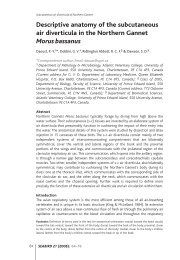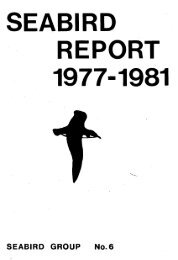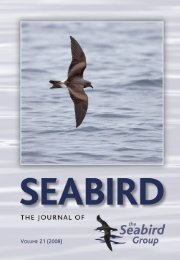You also want an ePaper? Increase the reach of your titles
YUMPU automatically turns print PDFs into web optimized ePapers that Google loves.
206 T. KRÜGER & S. GARTHE Atlantic <strong>Seabird</strong>s 3(4)<br />
Table 1. <strong>The</strong> correlation (r) between the percentage of birds passing Wangerooge in<br />
autumn 1999 and wind speed, grouped according to wind direction and flight<br />
altitude. Correlation coefficient r is in italics where p< 0.05 (cf. Fig. 2).<br />
Tabel 1. Correlatie (r) tussen het aandeel vogels dat Wangerooge in het najaar van<br />
1999 passeerde en de windsnelheid, gegroepeerd naar windrichting en<br />
vlieghoogte. Correlatiecoëfficiënt r is cursief indien p < 0.05 (cf. Figuur 2).<br />
Headwind Tail wind<br />
Low Low<br />
Red-throated Diver 0.295 -0.720<br />
Common Eider 0.550 -0.770<br />
Common Scoter 0.223 -0.668<br />
To minimise distortion of the results through other meteorological<br />
factors, rainy, hazy and foggy days during the period of the investigation were<br />
excluded from the evaluation (cf. Bruderer 1971). In order to correlate the<br />
observed migration with the wind, measurements of wind speed and wind<br />
direction were taken from a meteorological station on Minsener Oog (8 km E of<br />
Wangerooge; Wasser- und Schiffahrtsamt W ilhelmshaven, Abt.<br />
Gewässerkunde). During the study, the main migration direction was west.<br />
Consequently, winds from SW-NW are defined as headwinds, those from SE-<br />
NE as tail winds.<br />
RESULTS<br />
Flight altitudes in relation to wind speed and direction<br />
Red-throated Diver Gavia stellata During headwinds, most Red-throated<br />
Divers migrated low over the water (range: 60-100%; Fig. 2). <strong>The</strong> proportion of<br />
low-flying birds increased with increasing wind speed, and was up to 100%<br />
beyond speeds of 10.8 m s -1 . High-flying individuals were seldom recorded in<br />
headwinds and even then the breezes were only light.<br />
During light tail winds, the greatest percentage of Red-throated Divers<br />
were still low-flyers, even though this decreased significantly with increasing<br />
wind speed (Table 1, Fig. 2). <strong>No</strong> low flying Red-throated Divers were recorded<br />
in tail winds of over 15.4 m s -1 . Thus, the proportion of birds flying at medium<br />
height became greater with increasing wind speed. High-flying Red-throated<br />
Divers – rarely observed in headwinds – made up as much as 90% of the<br />
individuals in tail winds. <strong>The</strong>ir proportion increased in general with wind speed.








